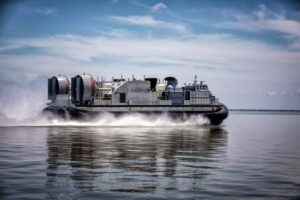The Navy is planning to have four Ship to Shore Connectors (SSCs) delivered per year and is progressing through testing before initial capability planned for 2023.
“We’re positioned very well where we’re going to be at four deliveries per year going forward. We think that’s achievable. We’ve had two deliveries each of the last two years. We’ve got a nice full production line now, so the pump is fully primed and now there’s not anything backing it up at the exit, which was some technical issues – so we worked through those so things are moving smoothly now,” Capt. Scot Searles, program manager for the Amphibious Assault and Connectors Program Office (PMS-317), said on Wednesday during the annual Surface Navy Association symposium.
The SSC program is made up of the
Textron Systems [TXT] Landing Craft Air Cushion (LCAC)-100, which aims to replace the Navy’s aging fleet of LCACs reaching the end of their service lives. The new craft are designed to operate for 30 years and transport 60 to 70 tons of surface force personnel, weapons, equipment and cargo at over-the horizon distances from amphibious ships. The SSC improves over the older model with better engines, higher payloads, smaller crew, fly-by-wire controls, and simpler maintenance.
The SSC previously hit rough seas with various delays and problems to fix. Textron was first awarded the first vessel, LCAC-100, in 2012 but in 2019 the Navy cut near-term procurement and pushed back full operational capability due to contractual and delivery delays related to electric system stability and command, control, communications, computers and navigation (C4N) integration (Defense Daily, April 3, 2019).
But the program has captured its footing, Searles said.
“I think we’ll get to four this year, if not it’ll be three with one that just barely missed being this year. So I think 2023 we’ll see four craft deliveries and I would expect to see that going forward at a very steady rate,” he said.
Most recently, the Navy received LCAC-104 last month, which is set to move to Naval Surface Warfare Center (NSWC) Panama City, Fla., “very soon” for testing and evaluation.
Over the next year and a half he said the program challenges will be making sure they can continue to learn, test the initial craft, and incorporate lessons learned into the other vessels. The Navy-Textron team has to build and maintain the delivery rate but not sacrifice incorporating feedback.
“The big challenge we’re going to see is how quickly can we close that feedback loop. As we test the craft and we find out things about reliability, maintainability, sustainability, we’ve got to very quickly pivot and get those things back in the production line. Otherwise, at the rate of four per year you will have a whole bunch already out there before you’ve incorporated a single fix,” Searles continued.

He said over the next year the SSCs will be undergoing developmental testing, operational testing and integration testing.
“So that’s a lot to do at one time, you can do either one of those great independently, we have to do all of them great together or it all falls apart.”
Searles noted the program appears to have solved a newer issue with microcracks in the propeller blades.
“So we conducted a lot of studies and we went through a lot of analysis of what was causing that back in 2020. They characterized the composites, the nature of the cracks, how they were occurring, used that information to develop a solution, both to strengthen the blade design – reinforce blade design and also to modify the propeller control software. So both of those fixes were implemented and tested at Panama City, proved out in 2020.”
The fix is being backfit to the existing vessels and forward fit into all the craft going forward.
Searles said they went through acceptance trials in December 2021 on LCAC-103 and “didn’t see any issues at all so we believe we’ve retired this issue with these two fixes to address those.”
He noted there is also a parallel issue to investigate a potential alternate solution with lower lifecycle costs and the program may introduce a new blade design later on rather than the current solution of reinforced blades plus software changes.
Otherwise, Searles said the SSC program continues post-delivery test and trials with the first four craft delivered to the Navy and 24 more on contract while the program is working on an acquisition strategy for future vessels. A follow-on Request For Proposals is due to come out this year “that’ll move on with procuring more craft.”
The Navy plans to ultimately procure 72 total LCAC-100s, largely built at Textron’s New Orleans shipyard. Initial Operational Capability (IOC) for the SSCs is planned in 2023.
“We’ve been seeing a steady upward trend of performance of each craft, successively getting better and better, so each one we take through trials is better than the last one, which is a great trend.”
The program is focused on both going through all the testing and evaluation like beach testing and meeting requirements in the capability development document (CDD) and also keeping schedule for IOC in 2023 with delivering craft and getting them to the fleet.
Searles said the next big event for the LCAC-100 class is the first live well deck testing. In February the first SSC craft is due to conduct the first live well deck testing onboard the USS Carter Hall (LSD-50), a Harpers Ferry-class dock landing ship. Previously, the Navy has only tested the vessel on a mock well deck at NSWC Panama City. The Navy will also conduct overland testing over the beach from LSD-50.